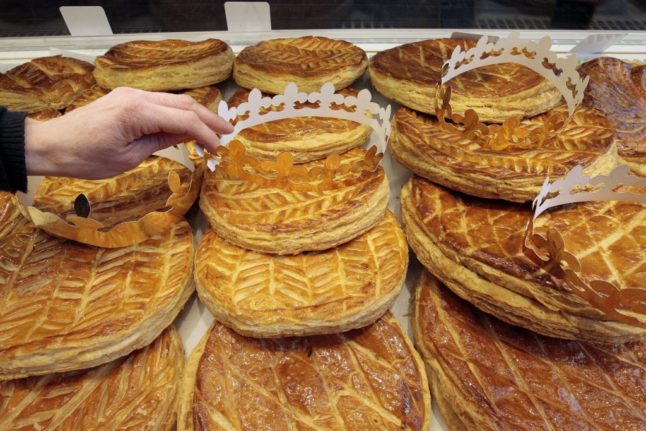As with many festivals in France, the feast of the Epiphany has its own special food.
Whereas Christmas and New Year’s Eve is all about oysters and foie gras, January 6th is all about the Galette des Rois (Kings’ Cake).
So what is a Galette des Rois?
It’s basically a frangipane tart made with pastry, butter, ground almonds and a few extra ingredients that will stretch the already bursting waistline for one final time before the January dieting begins.
In most areas the tart is flaky pastry and frangipane but in some parts of the south, especially Provence, the tart is made with brioche instead of pastry. There are also versions available with a fruit compote filling – usually apple – instead of frangipane.
It is eaten on January 6th each year to mark the feast of the Epiphany – when the three kings (allegedly) turned up to give gifts to Baby Jesus and the traditional accompaniment is cider.
The tradition of eating the cake dates back to the 14th century. According to tradition the cake was to draw the kings to the Epiphany.
Interestingly during the French Revolution the name was changed to Gâteau de l’egalité (equality cake) because it wasn’t really the done thing to be a king at that time.
Ah but it isn’t. The Galette des Rois is not just about having a cup of tea and something sweet. There’s an age-old protocol that needs to be followed and it’s all to do with the little charm (known as the fève or the bean) that bakers hide inside the cake.
First of all the youngest child (or youngest person at the gathering if no children are available) has to hide under the table and tell whoever is cutting the cake who should get which piece.
Whoever finds the charm, known as a fève, in their slice (as long as they don’t swallow it) gets to wear the gold paper crown that comes with the tart. As the name suggests, traditionally the fève was a bean but these days it’s usually a ceramic charm that is either shaped or decorated.
And then everyone just sits down and scoffs it. Normally with either cider or champagne.
And of course we can always rely on Richard Legay, the famous baker from the Marais district of Paris, to come up with his own special take on the galette – see pics below. His boulangerie Legay Choc is well known for creating penis-shaped patisseries.
And naturally, this being France, there is also a fierce local rivalry between northerners who love a frangipane galette and southerners who think brioche is king.
What’s the point?
It’s tradition of course (well maybe not the penis-shaped ones). According to Direct Matin newspaper, the pagan custom dates back to Roman times, when festivals were organised in honour of the gods between late December and early January.
Masters and slaves ate together and a bean was slipped into one of the dishes and whoever got it was hailed king of the feast.
When the church instituted the festival of the Epiphany to celebrate the arrival of the three wise men/kings, the tradition of the bean in the cake remained.
So everyone in France will have their cake and eat it?
Pretty much. Boulangeries in France love this time of year as their takings are boosted by the sale of the pastries.
Unfortunately the soaring price of butter this year means that buyers are likely to see an increase of around €1-2 in the price of their cake.
And spare a thought for Emmanuel Macron – who is not allowed the chance to become king for the day.
The French president is not allowed to “draw the kings” on Epiphany because of the etiquette rules. “Therefore, a traditional galette without figurine or crown is served at Elysée Palace.”
He does get a giant galette though, as the president traditionally hosts boulangers at the Elysée for a ceremonial cutting of an especially big tart.



 Please whitelist us to continue reading.
Please whitelist us to continue reading.
I think you meant to write scarf, as in “They scarfed it down”.. meaning to eat voraciously.